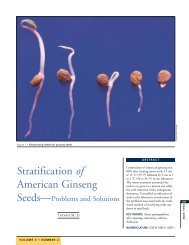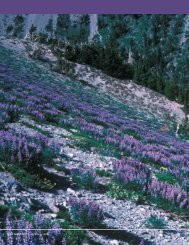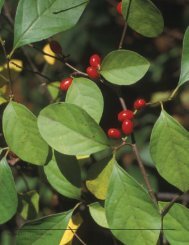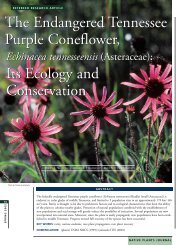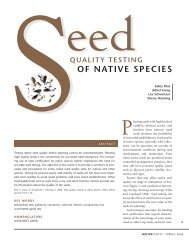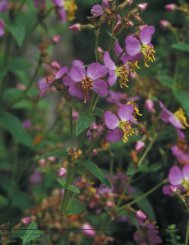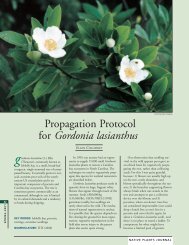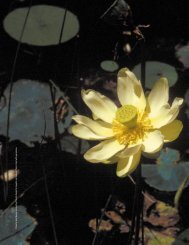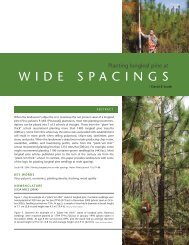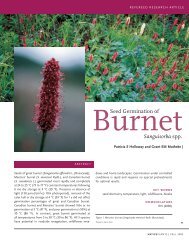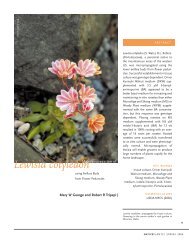species legume - Native Plants Journal
species legume - Native Plants Journal
species legume - Native Plants Journal
You also want an ePaper? Increase the reach of your titles
YUMPU automatically turns print PDFs into web optimized ePapers that Google loves.
REFEREED RESEARCH ARTICLE<br />
Effects of Temperature<br />
on Germination of 10 <strong>Native</strong><br />
<strong>legume</strong><br />
<strong>species</strong><br />
Robert L McGraw, Floyd W Shockley,<br />
and Theresia K Elam |<br />
ABSTRACT<br />
Seeds of 10 <strong>species</strong> of <strong>legume</strong>s native to Missouri germinated<br />
poorly when the temperature was lower than 15 °C (59 °F). The<br />
fastest time to first germinated seed occurred at 20 °C (68 °F)<br />
for all <strong>species</strong> except purple and white prairie clover, which germinated<br />
first at 25 °C (77 °F). The fastest germination rate was<br />
first reached at 20 °C (68 °F) for hoary tick clover, sessile tick<br />
clover, and slender lespedeza, at 25 °C (77 °F) for white prairie<br />
clover, purple prairie clover, panicled tick clover, hairy lespedeza,<br />
and tall lespedeza, and at 30 °C (86 °F) for Illinois<br />
bundleflower and roundhead lespedeza. Maximum total germination<br />
percentage also varied among <strong>species</strong>. For both the<br />
prairie clovers and roundhead lespedeza, hairy lespedeza, and<br />
slender lespedeza, the lowest temperature at which maximum<br />
total germination percentage occurred was 15 °C (59 °F). For<br />
Illinois bundleflower and the 3 tick clovers, the lowest temperature<br />
at which maximum total germination percentage occurred<br />
was 20 °C (68 °F). For most <strong>species</strong>, the fastest germination<br />
rate occurred at a higher temperature than the maximum germination<br />
percentage. Many <strong>species</strong> attained maximum germination<br />
percentage and fastest germination rate across a range<br />
of temperatures rather than at a single optimal temperature.<br />
Species that rapidly and completely germinate across a wide<br />
range of temperatures should germinate more reliably under<br />
variable soil conditions than <strong>species</strong> that exhibit a narrow range.<br />
KEY WORDS<br />
germination rate index, seed, Dalea candida, Dalea purpurea,<br />
Desmanthus illinoensis, Desmodium canescens,<br />
Desmodium paniculatum, Desmodium sessilifolium,<br />
Lespedeza capitata, Lespedeza hirta,<br />
Lespedeza stuevei, Lespedeza virginica<br />
Slender lespedeza (Lespedeza virginica (L.) Britton).<br />
Photo by Thomas G Barnes<br />
NOMENCLATURE<br />
Yatskievych and Turner (1990)<br />
5<br />
NATIVEPLANTS | SPRING 2003
Interest in restoring native grasslands has led to increased<br />
interest in native <strong>legume</strong>s. These plants are an important<br />
component of grassland ecosystems because they can fix<br />
atmospheric nitrogen in association with rhizobia bacteria and<br />
can be an excellent food source for both wildlife and domestic<br />
livestock. Incorporating native <strong>legume</strong>s with native, warm-season<br />
grasses can increase forage yield and quality in pasture and<br />
hay plantings (Posler and others 1993). Temperature is often the<br />
main environmental factor affecting seed germination when<br />
moisture is not limiting. Good seedling vigor and stand establishment<br />
is favored by prompt germination and rapid seedling<br />
development (Hur and Nelson 1985). Knowing the optimal<br />
temperatures for seed germination is necessary to develop management<br />
strategies for successful stand establishment.<br />
The effects of temperature on germination have been determined<br />
for many temperate introduced forage <strong>legume</strong>s. Hill<br />
and Luck (1991) studied the effects of temperature on the germination<br />
of 10 perennial pasture <strong>legume</strong>s. They found differences<br />
among <strong>species</strong> for time to first germination, maximum<br />
germination percentage, and rate of germination. Brar and<br />
others (1991) studied the germination of 20 forage <strong>legume</strong>s.<br />
They found that the <strong>legume</strong>s differed in temperature range for<br />
maximum germination and a majority of the entries tested<br />
exhibited a range in temperature for maximum germination<br />
between 10 and 25 °C (50 and 77 °C). Townsend and McGinnies<br />
(1972) studied the germination of 17 <strong>legume</strong> <strong>species</strong> and<br />
found that most <strong>species</strong> germinated successfully over a wide<br />
range of temperatures. Species adapted to a wide range of temperatures<br />
should be easier to establish than those with highly<br />
specific temperature requirements (Townsend and McGinnies<br />
1972; Brar and others 1991).<br />
Little is known about the effects of temperature on germination<br />
of native herbaceous <strong>legume</strong>s. Our objective was to<br />
determine the effects of temperature on the time to first germinated<br />
seed, total germination, and germination rate index<br />
for 10 native <strong>legume</strong>s.<br />
MATERIALS AND METHODS<br />
Seeds were collected by hand at each location from several<br />
randomly selected plants representative of the local population.<br />
During winter 1994, seeds of each entry were germinated in the<br />
greenhouse. In spring 1994, 30 seedlings of each entry were<br />
transplanted in 3 replicates (10 plants per replicate) to a field<br />
nursery located at Bradford Farm near Columbia, Missouri, in a<br />
spaced-plant arrangement with 1 m (3 ft) between plants and 1<br />
m (3 ft) between rows. In fall 1995, pods were hand harvested<br />
from each of the 30 plants of each entry. Thus, seeds of each entry<br />
were produced under similar environmental conditions, even<br />
though all were originally collected from different locations in<br />
Missouri. Seeds were threshed by hand using a rubboard and<br />
stored in a standard refrigerator at 4 °C (39 °F) until the germination<br />
tests were conducted in 1996. Just prior to initiating each<br />
germination test, seeds were removed from the refrigerator and<br />
handscarified by rubbing with sandpaper. Desmodium seeds<br />
were not scarified because tests showed that scarification did not<br />
improve their germination (data not shown). Immediately following<br />
scarification, seeds were surface sterilized with 95% ethyl<br />
alcohol for 3 min to reduce fungal growth during germination.<br />
Then, 3 sets of 100 seeds of each entry were placed on germination<br />
paper wetted with distilled water in a dark growth chamber<br />
for 28 d. Germination papers were rolled and placed in an open<br />
plastic bag to help retain moisture.<br />
The growth chamber was set at 10, 15, 20, 25, or 30 °C (50,<br />
59, 68, 77, or 86 °F, respectively). The experiment was conducted<br />
twice using 2 growth chambers. Each growth chamber<br />
was used for a complete set of temperature treatments. Germination<br />
counts were taken daily for 28 d. Seeds were considered<br />
germinated upon emergence of the radicle through the seed<br />
coat in accordance with the Association of Official Seed Analysts<br />
(AOSA 1965).<br />
The time to first germinated seed was recorded for each<br />
entry. Total germination percentage and germination rate<br />
index were calculated for each <strong>species</strong>. Total germination at<br />
each temperature was calculated from the total number of<br />
seeds germinated divided by the total number of seeds. The<br />
mean germination rate index was calculated using the method<br />
described by Maguire (1962) as:<br />
6<br />
Seeds from 1 entry of white prairie clover (Dalea candida Michaux<br />
ex Willd.), 1 entry of purple prairie clover (Dalea purpurea Vent.), 3<br />
entries of Illinois bundleflower (Desmanthus illinoensis [Michaux]<br />
MacMillan ex Robinson & Fern.), 1 entry of hoary tick clover<br />
(Desmodium canescens [L.] DC.), 3 entries of panicled tick clover<br />
(Desmodium paniculatum [L.] DC.), 1 entry of sessile tick clover<br />
(Desmodium sessilifolium [Torrey] Torrey and A. Gray), 4 entries of<br />
roundhead lespedeza (Lespedeza capitata Michaux), 1 entry of<br />
hairy lespedeza (Lespedeza hirta [L.] Hornem.), 2 entries of tall lespedeza<br />
(Lespedeza stuevei Nutt.), and 4 entries of slender lespedeza<br />
(Lespedeza virginica [L.] Britton) were collected from various sites<br />
across the state of Missouri in late 1992 and 1993 (Table 1).<br />
Germination Rate Index = (N i / D i )<br />
where N i is the number of seeds germinated out of 100 on the<br />
ith day and D i is the number of days from the start of the germination<br />
test to the ith day.<br />
Data were analyzed using the Statistical Analysis System<br />
(SAS) (SAS Institute 1985) to perform analysis of variance<br />
(ANOVA, PROC GLM; SAS Institute 1985) in a completely<br />
randomized design in which the treatments were arranged in a<br />
10 x 5 factorial (10 <strong>species</strong> x 5 temperature treatments). The<br />
linear statistical model included the effects of replication, temperature,<br />
and the interaction of replicate and temperature. The<br />
NATIVEPLANTS | SPRING 2003<br />
EFFECTS OF TEMPERATURE ON GERMINATION OF 10 NATIVE LEGUME SPECIES
effect of temperature represented the main plot and was tested<br />
using the interaction of replicate and temperature as the<br />
denominator of F. All other effects used the residual error for<br />
the denominator of F. Preliminary ANOVAs showed no significant<br />
interaction between entry and temperature, so all entries<br />
were pooled within each <strong>species</strong> for final analysis. Fisher’s Least<br />
Significant Difference (LSD) tests were performed to test for<br />
significant differences between temperature treatments within<br />
each <strong>species</strong> (Steel and Torrie 1960). All differences were<br />
reported as significant at P < 0.05. Because of the heterogeneous<br />
variance and relatively large ranges encountered with<br />
total germination percentage, that data were transformed<br />
using arcsine square root transformation to stabilize the variance<br />
(Snedecor and Cochran 1989). Significant differences in<br />
germination percentage were based on the transformed data,<br />
but untransformed data were used in the tables.<br />
RESULTS<br />
Warmer temperatures tended to reduce the time to first germinated<br />
seed (Table 2). At the coolest temperature tested, 10 °C,<br />
hoary tick clover, panicled tick clover, and sessile tick clover failed<br />
to germinate and the other 7 <strong>species</strong> averaged 26 d for time to<br />
first germinated seed. At 15 °C, the average time to first germinated<br />
seed for all <strong>species</strong> decreased to 11 d. For all <strong>species</strong> except<br />
white and purple prairie clover, the fastest time to first germinated<br />
seed occurred at 20 °C and did not differ significantly for<br />
the 20, 25, and 30 °C treatments. The fastest time to first germinated<br />
seed for white and purple prairie clover occurred at 25 °C,<br />
which did not differ significantly from 30 °C. Thus, use of time to<br />
first germinated seed for analysis separated the 10 <strong>species</strong> into 2<br />
groups: <strong>species</strong> that germinated fastest at either 20 or 25 °C.<br />
When germination rate index was used to analyze the effect<br />
of temperature on germination, different patterns emerged for<br />
some <strong>species</strong> when compared to using time to first germinated<br />
seed. Germination rate index is the summation of the daily<br />
germination rate and takes into account the rate at which seeds<br />
germinate across time. The germination rate index can range<br />
from a minimum of 0 to a maximum of 100, with larger numbers<br />
representing faster germination rates. Because it measures<br />
time to germination of all seeds and not just the first seed to<br />
germinate, it is probably a better predictor of the effects of<br />
temperature on germination rate.<br />
None of the <strong>species</strong> had their largest germination rate index<br />
at 10 or 15 °C (Table 3). For 3 <strong>species</strong>, hoary tick clover, sessile<br />
TABLE 1<br />
Collection information for native <strong>legume</strong>s (Fabaceae) tested for germination at various temperatures.<br />
Scientific Name Common Name Entry Collection Site a Collection Date<br />
Dalea candida White prairie clover 59 St Clair , Dade 19 to 20 Sep 1993<br />
Dalea purpurea Purple praire clover 71 Laclede 29 Jul 1993<br />
Desmanthus illinoensis Illinois bundleflower 15 Pike 12 Aug 1993<br />
61 St Clair 19 Aug 1993<br />
72 Texas 29 Jul 1993<br />
Desmodium canescens Hoary tick clover 25 Boone 8 Sep 1993<br />
Desmodium paniculatum Panicled tick clover 8 Adair 8 Sep 1993<br />
29 Boone 6 Sep 1993<br />
76 Texas 29 Jul 1993<br />
Desmodium sessilifolium Sessile tick clover 63 St Clair , Dade 19 to 20 Sep 1993<br />
Lespedeza capitata Roundhead lespedeza 4 Atchison , Holt 26 to 27 Aug 1993<br />
10 Adair 14 Aug 1993<br />
31 Boone 8 Sep 1993<br />
78 Texas 12 Nov 1992<br />
Lespedeza hirta Hairy lespedeza 43 Cole , Osage 21 and 28 Jul 1993<br />
Lespedeza stuevei Tall lespedeza 45 Cole , Osage 21 and 28 Jul 1993<br />
99 Barry 19 Aug 1993<br />
Lespedeza virginica Slender lespedeza 11 Adair 14 Aug 1993<br />
46 Cole , Osage 21 and 28 Jul 1993<br />
80 Texas 4 Dec 1992<br />
89 Oregon 29 Jul 1993<br />
a All collection sites are counties within the State of Missouri.<br />
7<br />
ROBERT L MCGRAW, FLOYD W SHOCKLEY, AND THERESIA K ELAM NATIVEPLANTS | SPRING 2003
TABLE 2<br />
Days to first germinated seed of native <strong>legume</strong>s as influenced by<br />
temperature. Lower numbers indicate faster overall<br />
emergence for each temperature treatment.<br />
TABLE 3<br />
Germination rate index a of native <strong>legume</strong>s as influenced by temperature.<br />
Higher numbers indicate faster overall emergence<br />
for each temperature treatment.<br />
Temperature (°C)<br />
Species 10 15 20 25 30<br />
d<br />
White prairie clover 27 c a 8 b 5 b 2 a 2 a<br />
Purple prairie clover 27 c 9 b 5 b 2 a 2 a<br />
Illinois bundleflower 26 c 10 b 4 a 3 a 2 a<br />
Hoary tick clover NG b 17 b 6 a 5 a 5 a<br />
Panicled tick clover NG 18 b 8 a 6 a 4 a<br />
Sessile tick clover NG 17 b 6 a 5 a 6 a<br />
Roundhead lespedeza 26 c 9 b 4 a 3 a 2 a<br />
Hairy lespedeza 27 c 8 b 4 a 3 a 2 a<br />
Tall lespedeza 28 c 14 b 6 a 3 a 3 a<br />
Slender lespedeza 26 c 7 b 4 a 3 a 3 a<br />
Mean 26 c 11 b 5 a 4 a 3 a<br />
Temperature (°C)<br />
Species 10 15 20 25 30<br />
White prairie clover 1 c b 5 b 10 b 18 a 17 a<br />
Purple prairie clover 1 d 5 c 10 b 23 a 19 a<br />
Illinois bundleflower
TABLE 4<br />
Total germination percentage of native <strong>legume</strong>s as<br />
influenced by temperature at 28 d after planting.<br />
Temperature (°C)<br />
Species 10 15 20 25 30<br />
%<br />
White prairie clover 3 b a 65 a 62 a 59 a 47 a<br />
Purple prairie clover 3 b 67 a 69 a 73 a 57 a<br />
Illinois bundleflower 3 c 44 b 55 ab 56 a 59 a<br />
Hoary tick clover 0 c 33 b 57 a 52 ab 48 ab<br />
Panicled tick clover 0 c 25 b 78 a 76 a 69 a<br />
Sessile tick clover 0 c 39 b 73 a 66 a 37 b<br />
Roundhead lespedeza 5 b 63 a 69 a 65 a 65 a<br />
Hairy lespedeza 1 b 69 a 65 a 70 a 58 a<br />
Tall lespedeza



